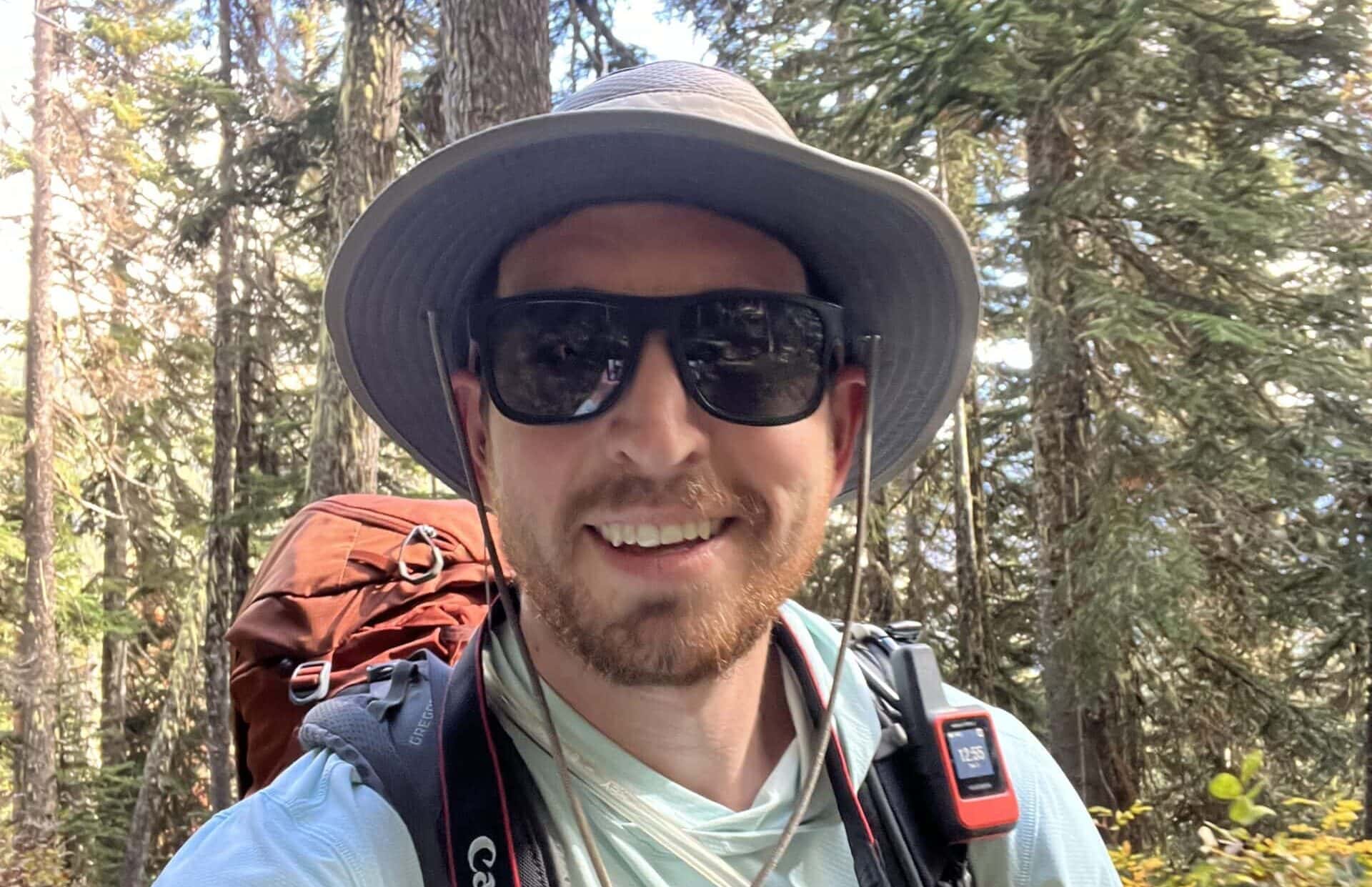Ultimate Guide: Hiking Angels Landing in Zion National Park
Angels Landing is the must-see of ‘must-see’ places not only in Zion but throughout the National Parks system. I’ve hiked this trail multiple times – as a young kid with my parents and then with friends, even coming down in the dark.
Jutting out from the canyon wall into the center of Zion National Park, Angels Landing is one of the best Utah hikes.
It’s undoubtedly why it was named what it was. Even angels couldn’t miss it. The Angels Landing view is so phenomenal words can’t really do it justice. Even if you aren’t much of a hiker or outdoorsy person, you’ve undoubtedly heard or seen someone talk or post about the exhilarating experience.
While people will rave about the hike – for good measure – it isn’t long or that complex, meaning you can do plenty before or after your hike if you plan it right.
Why you can trust me: You can trust that this blog is authentic and real because I have Angels Landing twice, and I recommend it to everyone. I try to use my blog like I’d talk to my friends, and this is a hike you’ll be stoked about!

Complete Guide: How to Survive Hiking Angels Landing
One Minute Angels Landing Hiking Details:
- Distance: ~5 miles round trip
- Elevation Gain: 1,600 feet
- Difficulty: Moderate to Hard (Not advised for those with a fear of heights)
- Beauty Level: Stunning
- Travel Distance: 20 minutes on the bus from the entrance
What you need to know before your Angels Landing hike
Is Angels Landing worth it?
Yes. Yes. Yes. Angels Landing is 100% worth it, and everyone who can do it should. It will test you mentally and physically and offers fantastic views of Zion Canyon. Overall, it’s just a dang good hike, and almost everyone who does it loves it.
However, I will note that Observation Point, above Angels Landing, is even cooler, has fewer crowds, and no permit is needed.
Permits Are Now Required
In order to hike to the top of Angels Landing in Zion National Park, you must carry a permit. Those without permits can still hike 2.25 miles to Scout Lookout on the West Rim Trail. This is strenuous and offers beautiful views of the canyon.
But from Scout Lookout to Angels Landing requires a permit.

How to get Permits for Angels Landing
There are two ways to get an Angels Landing Permit. The first is to apply for the season lottery. This happens four times a year and lets you know if you landed one or not a month beforehand. (For
Example: On October 1, permits opened up for dates spanning December 1 to February 29, 2024. The lottery closed on October 25, and those who entered will learn if they won on October 25.
You can also apply for a ‘Day Before Lottery,” which opens every day at 12:01 am and closes at 3 pm MT. This is exactly as it sounds. You’re applying to hike Angels Landing the following day.
If you get a permit, make sure to save it to your phone or print it off. You’ll be asked about it by rangers on the hike.
Shuttle or Bike Required
Unless you are staying at the lodge or receive a handicap permit, tourists are not allowed to drive their personal vehicles into Zion Canyon. This means the only way in is to hop on the Zion National Park Shuttle or to bike in.
Both are phenomenal options but know that the shuttle has a last ride, and during the summer months, that may not correlate with a sunset hike. Make sure not to get stranded on your hike, or you will not have a great time walking back in the dark.
The best time to Visit Angels Landing?
Honestly, Zion National Park is pretty great to visit year-round. It does get warm in July and August, but early mornings and evenings can be lovely.
The best time to visit would be spring and fall (with fewer crowds), but checking out Zion in Winter can be magical if you want to brave lower temperatures and some snow. If you go in winter, ensure you have the best winter hiking gear and winter hiking boots.

Low Cell Phone Ability
Having decent or any cell phone service is low in Zion National Park and especially in Zion Canyon. Do not rely on it; instead, carry a satellite communications device to ensure you can help if needed.
What to Expect Hiking Angels Landing
Angels Landing is not that hard of a hike. It’s tough, but it won’t crush you. Less than three miles each way, this can be done in under four hours if there isn’t a lot of traffic coming up or down.
West Rim Trail Portion
The first portion hiking Angels Landing, on the West Rim Trail, is pretty standard National Parks hiking. From the start to the beginning of Walters Wiggles is about 1.5 miles with around 900 feet of elevation gain. Here, you’ll get some great views of the canyon and of Angels Landing herself.
After the first quarter-mile, which is generally flat, you’ll start getting your blood pumping.
Walters Wiggles
Then come Walters Wiggles. These 11-ish switchbacks will have your legs burning as you endure switchback after switchback for approximately 75 vertical yards. Other than the fact that it looks (which is really cool), there’s not much to say about this section.
Once you’re past the wiggles, you have the spine to tackle.
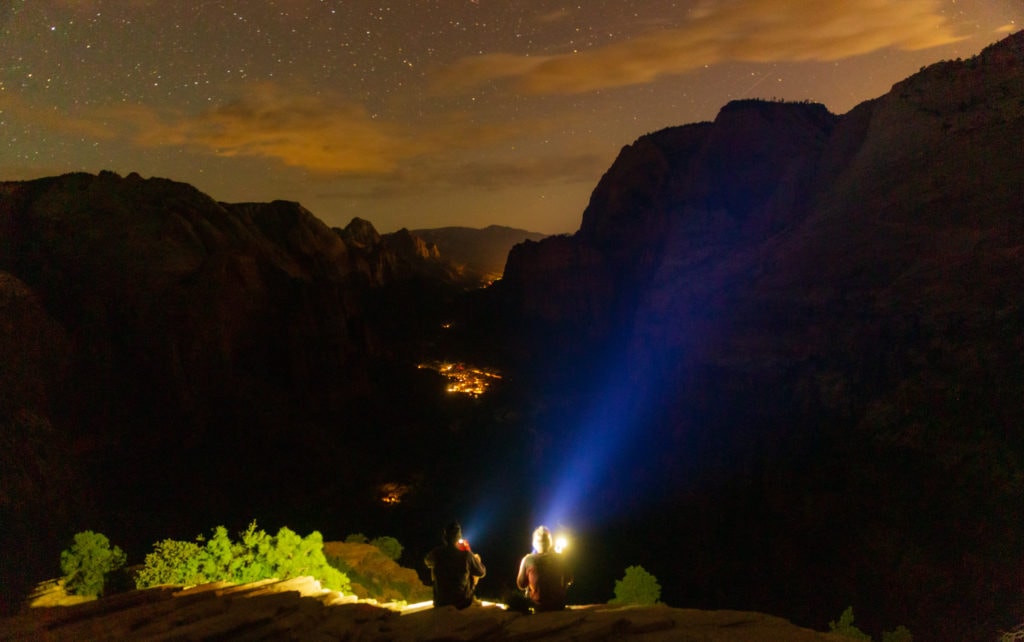
Staying Safe on Angels Landing Spine
This is where the heebie-jeebies will come into play. I believe that people overdramatize the risk level of the hike. Yes, there are steep drop-offs of 1,500 feet, but you don’t get that close if you pay attention and are safe.
And yes, people do die, but as someone who has done it now three times – once as a younger kid and once at night – I never felt like my life was in danger.
Take your time, make sure you have three points of contact with the trail, and you’ll do great. If you’re nervous, try to be the first ones up in the morning to decrease the amount of people on the trail.
Hiking to the top of Angels Landing
From Scout Lookout to the top of Angels Landing is about half a mile – give or take. You will also gain around 500 feet (there is a section where you drop 100 feet down and then have to come back up).
This section is not one to mess around with. Be sure to be on top of your game while traversing the steep sections.
With the spine, some portions have chains to help you up, over, and around some bends and steps. Use the chains. They are there for your benefit.
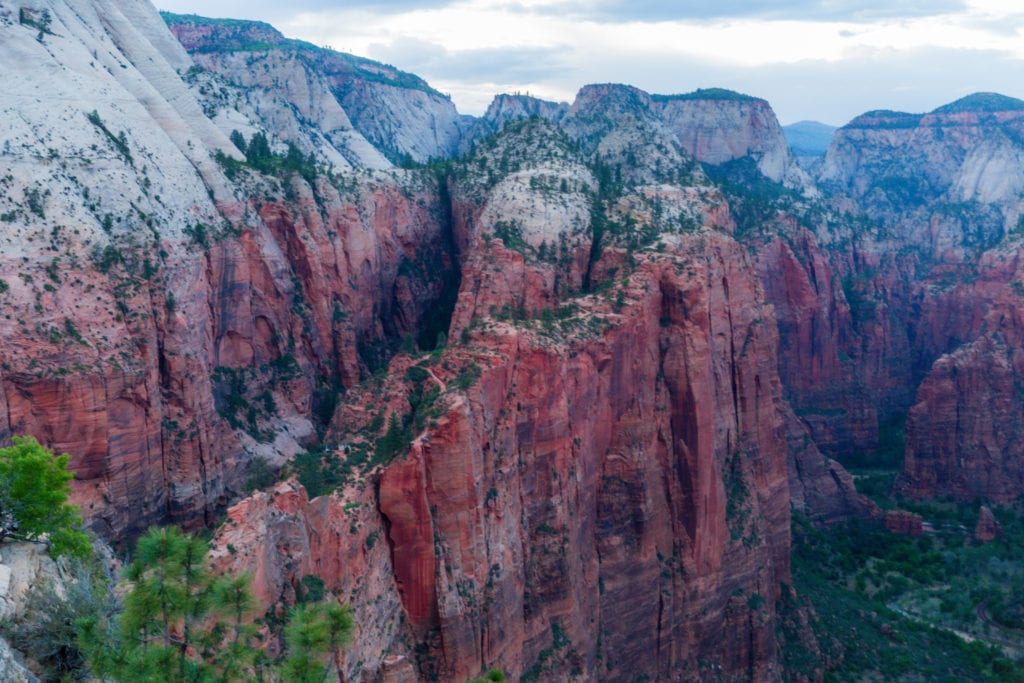
Also, realize that these areas are the riskiest during the most crowded times. People will pass by, and hikers could easily be knocked off balance on Angels Landing. This is how accidents happen.
At the top, though, there’s no risk unless you get too close to an edge. It is an open area, and feel free to relax, eat your snacks, and enjoy the view.

How to Hike Angels Landing Off Peak
Everyone goes to Zion in the summer. It’s when kids are out of school. It’s when vacations happen. So, yes, I know it makes planning challenging, but don’t go to Zion National Park during summer. Early spring or late fall is the best to avoid large crowds, and you’ll have much better weather.
If you visit in the summer months, you can hike late into the evening as there is still light past 9 p.m. This can help you beat the heat and the crowds.

What To Bring Hiking Angels Landing
Angels Landing is a popular and challenging hike located in Zion National Park, Utah. To ensure a safe and enjoyable experience, it’s essential to come prepared. Here’s a list of items to bring with you when hiking Angels Landing:
Water: Staying hydrated is crucial. Carry at least two liters of water, especially hiking during the warmer months.
Sturdy Footwear: Wear comfortable, sturdy hiking shoes or boots with good grip and ankle support. The terrain can be rocky and steep.
Weather-Appropriate Clothing: Dress in layers, as the weather in Zion can vary. Be prepared for the sun, but also bring a lightweight jacket in case it gets cold or rainy.
Sun Protection: Wear a wide-brimmed hat and sunglasses, and use sunscreen. The sun in the Zion Canyon can be intense.
Backpack: A small backpack to carry your essentials, such as water, snacks, and extra clothing.
Snacks: Pack energy-boosting snacks like granola bars, trail mix, or fruits to keep your energy up during the hike.

Map and Compass: While the trail is well-marked, it’s always a good idea to have a map and compass or GPS device in case you need them.
First Aid Kit: Carry a basic first aid kit for any minor injuries or emergencies.
Hiking Poles (optional): Hiking poles can provide extra stability on the steep sections of the trail.
Camera: Don’t forget your camera or smartphone to capture the stunning views along the way. Just be careful when taking photos near edges.
Trash Bag: Pack out all of your trash. Leave no trace and help keep the park clean.
Permit (if required): Depending on the season, you may need a permit to hike Angels Landing. Check with the Zion National Park website for current permit requirements.
Identification and Important Documents: Carry identification and any necessary park permits or passes.

My Tips for Hiking Angels Landing
Suggestion 1:
If you feel comfortable with your hiking ability, I would suggest a sunset hike for Angels Landing. Odds are, you might have the place to yourself and, if not, only have a few other people up there. If you do this, you could begin hiking down right around sunset and be down off the spine by the time it gets dark. Or, you could watch the stars come out on top!
If you do this course of action, make sure to have a bike to ride back on, check the shuttle schedule and see if it goes later, or have someone drive in and grab you. (This might be frowned upon, but there’s no one checking.)
Suggestion 2:
The second option is to be on the day’s first shuttle and then out-hike everyone else. Another variety of this is to bike in so you can be on the top for sunset and then get a ride out by putting your bike on the shuttle bus.
Both of these options are designed to minimize your crowds hiking Angels Landing and maximize your photography chances.
What other hikes are near Angels Landing?
There are several great hikes near Angels Landing in Zion National Park. Here are five hikes and a brief summary of each:
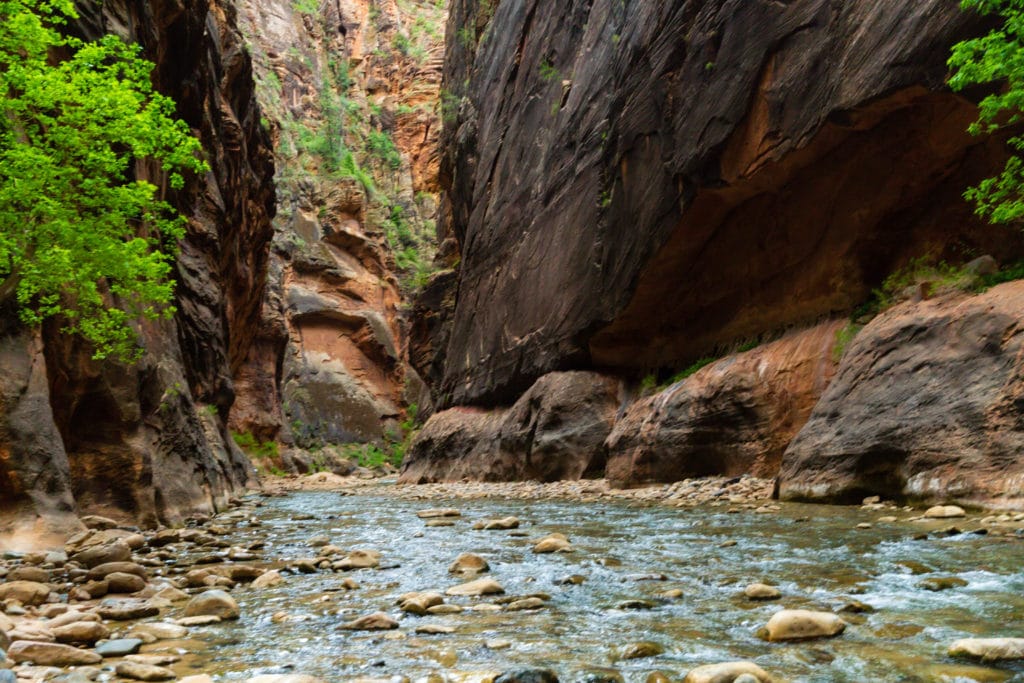
The Narrows:
The Narrows is one of the most iconic hikes in Zion National Park. It involves wading or walking through the Virgin River in a narrow slot canyon, often with towering sandstone walls on both sides. The hike can vary in length, but the most popular section is the “Bottom-Up” hike, which is about 5-miles round trip.
Emerald Pools Trail:
The Emerald Pools Trail is a family-friendly hike with three distinct pools at different levels. The lower pool is the easiest to reach, and the trail offers stunning views of waterfalls and lush vegetation. The entire loop is approximately 3 miles.
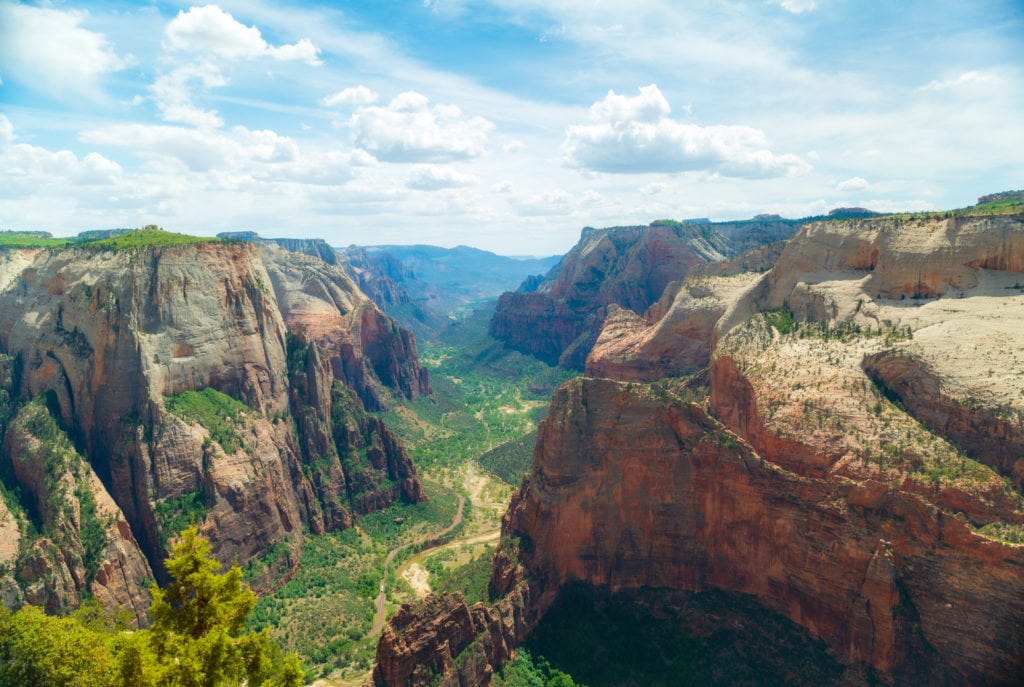
Observation Point:
Observation Point is another challenging hike that offers a breathtaking view of Zion Canyon from high above. The trail is about 8 miles round trip and ascends via a series of switchbacks, leading to a panoramic vista of the park.
Hidden Canyon:
Hidden Canyon is a moderately strenuous hike that leads to a narrow slot canyon with steep drop-offs and chains for assistance. The trail is approximately 2.4 miles round trip and provides a taste of adventure without the exposure of Angels Landing.

Canyon Overlook Trail:
Located on the east side of Zion National Park, the Canyon Overlook Trail is a short and relatively easy hike, making it an excellent option for those with limited time or mobility. The trail is about a 1-mile round trip and offers stunning canyon views, including a viewpoint with a dramatic overlook.
These hikes offer diverse experiences, from challenging and exposed routes to more family-friendly and accessible options. Depending on your fitness level and preferences, you can choose the hike that suits you best while exploring the beauty of Zion National Park. Always check trail conditions and safety guidelines at the park visitor center before hiking.
Lodging Around Angels Landing and Zion National Park
Hotels
📍Budget Option – Springhill Suites; Holiday Inn Express
📍Mid-Range Option – Zion Canyon Inn and Suites; Zion Lodge (Inside the Park)
📍Luxury Option – Under Canvas Zion; Cliffrose Springdale; Desert Pearl Inn
Camping
There are multiple campgrounds in Zion National Park. When you come, ensure you have the essentials and your camping checklist to not forget anything.
FAQ: Hiking Angels Landing
How long will it take to hike Angels Landing?
The time it takes to hike Angels Landing can vary depending on your fitness level and how crowded the trail is. On average, completing the round-trip hike to Angels Landing takes about 4 to 5 hours. This includes the strenuous ascent, time spent at the summit, and the descent.
Can beginners hike Angels Landing?
Angels Landing is a challenging and strenuous hike with steep switchbacks, narrow sections with drop-offs, and the need to hold onto chains in some areas.
While it’s not technically difficult, it can be physically demanding and mentally challenging, especially for beginners or those with a fear of heights. Many beginners attempt the hike, but it’s essential to be well-prepared, have proper footwear, and be aware of your limitations.
If you are a beginner hiker, you may want to consider some of the easier trails in Zion National Park before attempting Angels Landing.
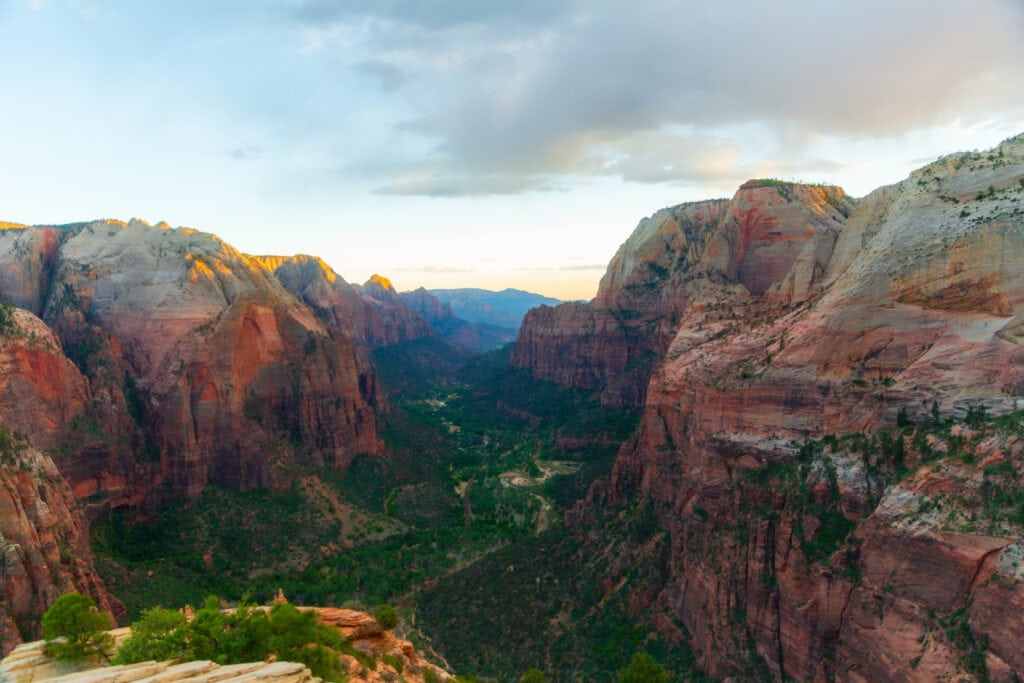
What are the odds of getting an Angels landing permit?
In 2022, less than half of lottery applicants were successful. Applying on the weekday or off-season will increase your chances.
Final Thoughts on Angels Landing
In conclusion, the Angels Landing hike in Zion National Park is an exhilarating and awe-inspiring adventure that offers breathtaking views of the surrounding landscapes.
While it requires physical stamina and a head for heights, the sense of accomplishment upon reaching the summit is unparalleled. The trail’s unique combination of challenging terrain, stunning vistas, and rich history make it a must-do experience for hikers seeking a thrilling and rewarding outdoor excursion.
Whether you are an experienced hiker or someone looking to push their limits, Angels Landing will leave you with lasting memories and a newfound appreciation for nature’s beauty.
Until next time, adventurers, take care and be safe.
Subscribe to my newsletter and follow for more: Instagram | TikTok | Facebook


